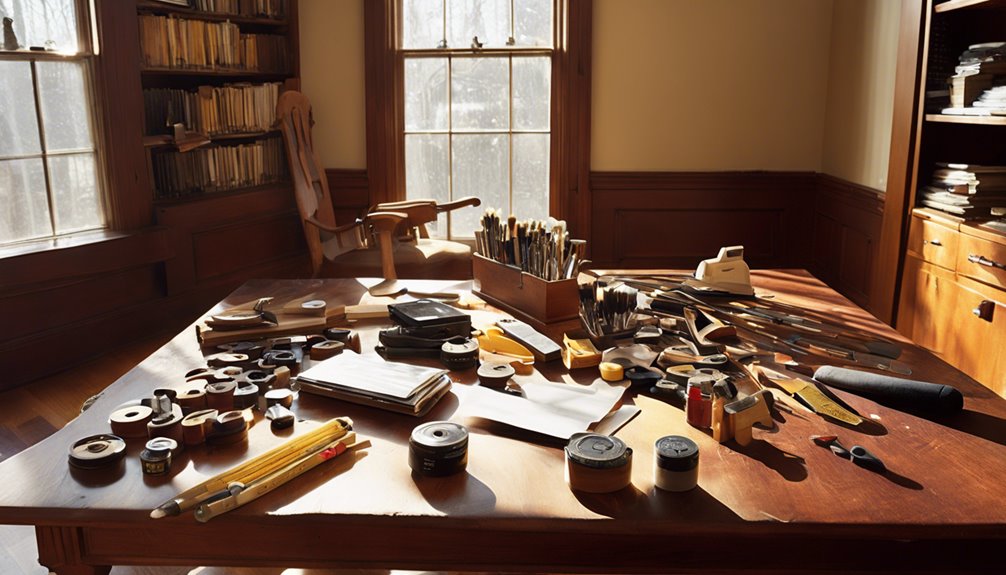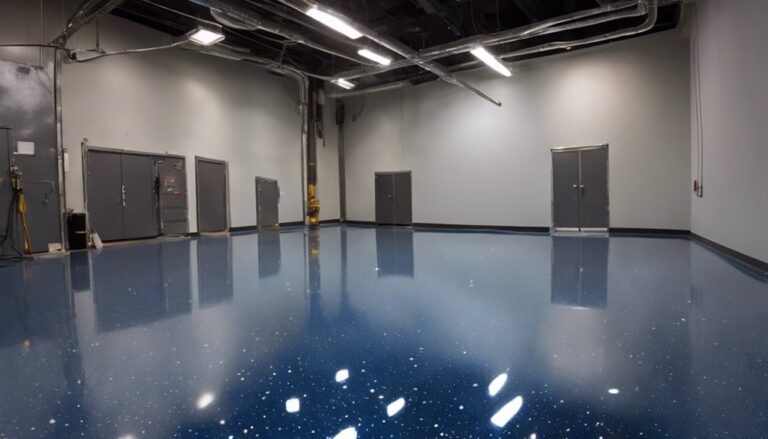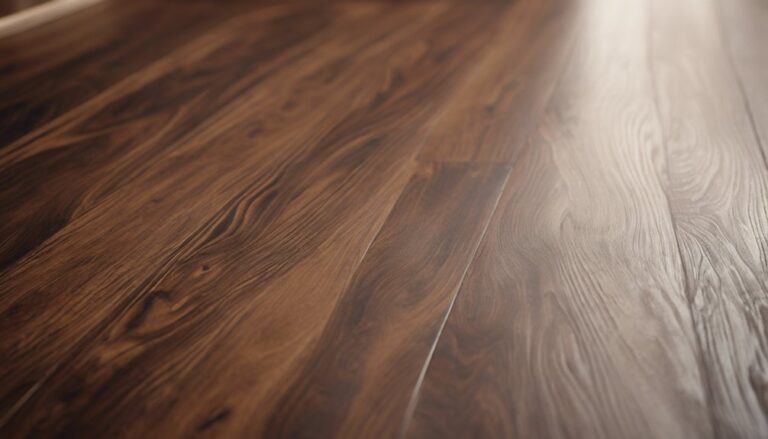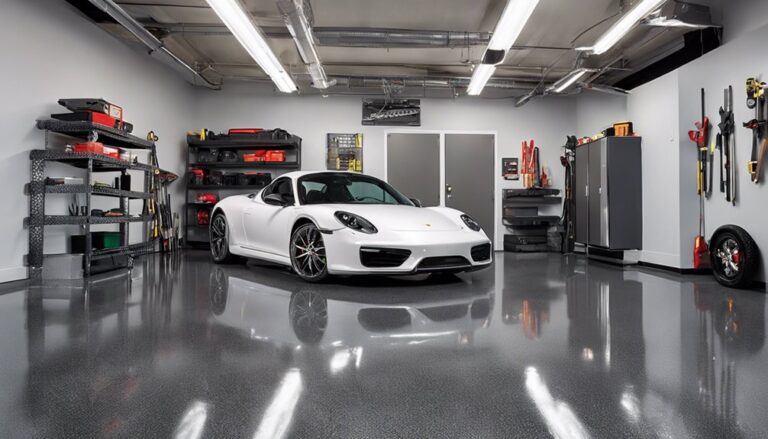Refinishing floors costs between $3 and $8 per square foot for hardwood and $1 to $3 per square foot for laminate. Several factors influence these rates, including the condition of the floors, the size of the area, and your geographic location. You might also consider whether to DIY or hire a professional, as DIY costs can range from $200 to $500, while professional services typically run from $1,500 to $3,500. Understanding additional charges for repairs or design intricacies is essential for accurate budgeting. Exploring these aspects will guarantee you make an informed decision.
Factors Influencing Refinishing Costs
When considering refinishing your floors, several factors can considerably influence the overall cost. The choice of flooring types plays a significant role; hardwood may require different refinishing techniques compared to laminate or tile. Each flooring type has its unique characteristics and may necessitate specialized tools or products. Additionally, the condition of your floors will impact the refinishing techniques employed, as deeper scratches or damage may require more extensive preparation, increasing labor costs. Factors like the size of the area and the intricacy of the design can also affect pricing. Ultimately, understanding these elements can empower you to make informed decisions that align with your budget while achieving the desired aesthetic for your space.
Average Cost of Hardwood Refinishing
On average, refinishing hardwood floors can cost between $3 to $8 per square foot, depending on various factors such as the type of wood, the condition of the floors, and your location. To maintain your floors effectively, consider following hardwood maintenance tips, which include regular cleaning and applying protective finishes. Refinishing frequency recommendations typically suggest refinishing every 5 to 10 years, depending on foot traffic and wear. Be sure to assess your floors' condition to determine the ideal timing for refinishing, as this can impact overall costs. Investing in timely refinishing not only enhances the aesthetic appeal of your home but also prolongs the life of your hardwood flooring, ensuring you enjoy its beauty for years to come.
Cost Breakdown for Laminate Floors
How much should you expect to spend on refinishing laminate floors? The cost typically ranges from $1 to $3 per square foot, depending on laminate types and the extent of the damage. For minimal surface scratches, a simple cleaning and polishing might suffice, costing around $0.50 to $1 per square foot. However, deeper scratches or wear may require more intensive work, increasing your expenses.
When budgeting, consider maintenance tips to prolong your investment. Regularly cleaning and using protective mats can reduce future refinishing needs. If you're planning to tackle this, remember that laminate floors can't be sanded or stained like hardwood, so understanding your specific laminate type is essential for effective maintenance and refinishing.
DIY Vs Professional Refinishing
When considering refinishing your floors, you'll need to weigh the costs associated with DIY versus hiring a professional. DIY may seem more budget-friendly, but it requires a specific skill set and access to the right tools, which can add hidden expenses. Evaluating your own capabilities alongside the potential quality of professional work will help you make an informed decision.
Cost Comparison
While choosing between DIY and professional refinishing for your floors, it's crucial to weigh the costs and potential outcomes. A thorough cost analysis reveals that DIY refinishing typically ranges from $200 to $500, covering materials like sanders, stains, and finishes. However, this doesn't account for your time and effort. On the other hand, hiring professionals may set you back $1,500 to $3,500, depending on the size and condition of your floors, along with pricing strategies employed by local contractors. Consider the trade-off between the upfront savings of DIY and the expert finish of professionals. Ultimately, understanding these costs will empower you to make an informed decision that suits your budget and desired aesthetic.
Skill Requirements
Refinishing floors requires a specific set of skills, whether you choose to tackle the project yourself or hire a professional. If you're considering a DIY approach, assess your skill levels honestly. You'll need to be comfortable with equipment requirements like sanders, buffers, and sealants. Mastery of these tools is essential to achieve a smooth, even finish.
On the other hand, professionals bring expertise that can save you time and guarantee high-quality results. They're familiar with various wood types and the intricacies of the refinishing process. While DIY can offer a sense of freedom, consider whether your skills match the project's demands. If not, hiring a professional might be the more efficient and satisfactory choice.
Estimating Square Footage Costs
How can you accurately estimate the cost of refinishing your floors? Begin with square footage calculations, as understanding the total area is essential for estimating material costs. Measure the length and width of each room, then multiply these dimensions to get the square footage. Don't forget to account for any irregular spaces or alcoves, as they can affect your total. Once you have the square footage, research the average cost per square foot for refinishing services in your area. This will help you gauge potential expenses. Additionally, factor in the type of finish you prefer, as different materials can vary markedly in price. With this information, you'll have a clearer picture of your refinishing project's overall cost.
Additional Charges to Consider
When planning your floor refinishing project, it's crucial to take into account additional charges that may arise beyond the basic square footage costs. You might encounter additional fees for moving furniture, repairs, or dealing with extra layers of finish. If your floors have significant damage, you could face hidden expenses related to sanding or replacing boards. Additionally, if your project requires specialized equipment or techniques, this can also increase costs substantially. Always ask your contractor for a detailed breakdown of potential extra charges to avoid surprises down the line. By understanding these factors, you can better prepare your budget and guarantee a smooth, hassle-free refinishing experience that aligns with your freedom to create the perfect space.
Cost of Supplies and Materials
Understanding the cost of supplies and materials is essential for accurately budgeting your floor refinishing project. You'll need to take into account various supply types, including sanders, finishes, and sealants. Each type has different price points, and material quality greatly influences your overall costs. High-quality products often yield better results and longer-lasting finishes, but they can also come with a higher price tag. For example, premium wood stains and finishes can enhance the aesthetic appeal and durability of your floors. It's vital to balance cost with quality, as opting for cheaper supplies may lead to increased maintenance and refinishing expenses down the line. By investing wisely in supplies, you'll achieve the desired outcome without compromising your budget.
Regional Price Variations
While the cost of refinishing floors can vary markedly across different regions, factors such as local labor rates, supply availability, and demand for services play essential roles in determining these price fluctuations. For instance, metropolitan areas often experience higher regional pricing due to increased local demand and a more competitive market, which can drive up labor costs. Conversely, rural regions might offer more affordable rates, reflecting lower demand and reduced overhead expenses. Additionally, the availability of supplies can influence pricing; areas with limited access to materials may incur higher costs. Understanding these regional dynamics can help you make informed decisions about your flooring project, ensuring you choose a service that meets both your budget and quality expectations.
Tips for Budgeting Your Project
Regional pricing variations can greatly impact your overall flooring budget, making it essential to plan effectively. Here are some budgeting strategies to contemplate that can help you prepare for unexpected expenses:
- Research local contractors and get multiple quotes.
- Allocate a contingency fund of 10-20% for unforeseen costs.
- Factor in additional materials and supplies that may be needed.
- Schedule the project during off-peak seasons for potential savings.
- Keep a detailed record of all expenses to monitor your budget.
Maximizing Value in Floor Refinishing
When you're looking to maximize value in floor refinishing, it's important to take into account both the quality of the work and the longevity of the results. Choose a reputable contractor with a proven track record to guarantee value preservation. High-quality materials and techniques will not only enhance the aesthetic appeal but also contribute to the durability of your floors, ultimately providing a greater return on investment. Consider periodic maintenance options that extend the lifespan of your refinished floors, reducing the need for frequent costly refinishing. Additionally, staying informed about market trends can help you make informed decisions that align with your property's value. Prioritizing these elements will guarantee you truly maximize the benefits of your refinishing project.
Frequently Asked Questions
How Long Does the Refinishing Process Usually Take?
When considering the refinishing timeline, you'll find that the process typically takes a few days. Initially, preparation and sanding can take one to two days, depending on the floor's condition. After that, the application of the finish requires additional drying time, which can range from several hours to a full day before you can walk on it. Overall, expect about three to five days for complete refinishing, including drying periods.
What Types of Finishes Are Available for Hardwood Floors?
You might think all finishes are the same, but they're not. For your hardwood floors, you've got options like oil finishes and water-based finishes. Oil finishes penetrate the wood, enhancing its natural beauty and offering a warm look, while water-based finishes dry quickly, providing a clear, durable layer that resists yellowing. Choosing the right finish can elevate your space, giving you the freedom to express your style while protecting your investment.
Can Refinishing Improve the Appearance of Scratched Floors?
Yes, refinishing can considerably improve the appearance of scratched floors. By employing various refinishing techniques, you can effectively restore the surface layer, removing scratches and blemishes. The process involves sanding down the damaged areas and applying a new finish, which not only enhances the aesthetic appeal but also protects the wood underneath. This treatment can breathe new life into tired floors, allowing their natural beauty to shine through once again.
Is It Necessary to Move Furniture Before Refinishing?
Yes, it's necessary to move furniture before refinishing your floors. Proper furniture protection is essential to prevent damage during the process. Additionally, moving logistics can be complex; you'll need to plan where to store your items temporarily. By relocating furniture, you guarantee a smooth refinishing process and avoid potential obstructions. This not only facilitates the refinishing work but also enhances the final appearance of your floors, giving you the freedom to enjoy your space.
Will Refinishing Floors Increase My Home's Value?
Refinishing your floors can greatly enhance your home's value. The refinishing benefits, such as improved aesthetics and durability, often lead to a higher property appraisal. Potential buyers are drawn to well-maintained hardwood floors, making your home more appealing. Additionally, a polished look can create a sense of freedom in your living space, allowing you to showcase your style. Overall, investing in floor refinishing can yield a strong return when it's time to sell.




